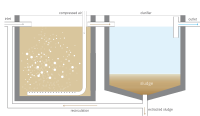Environmental Health Engineering Theory and Practice/Environmental Health Engineering: What it is and What it is Not
Environmental Health Engineering

In 1869, Florence Nightingale, the foundress of modern nursing published her now-famous book, Notes on Nursing: What it is and What it is Not. In this 76-page book, Nightingale outlined what she believed would be helpful guidance to be shared with others who wanted to practice nursing - to care for others. While we can find errors in Nightingale's book - now that we understand more and more about the science of illness and the promotion of wellness - it is amazing to note the areas where her work remains timeless. Indeed, what is now commonly known as Nightingale's environmental theory remains as relevant today as in a prior century. For example, Nightingale wisely noted that the natural state of a human is healthy, and that the primary purpose of the practice of nursing was to modify the environment around the patient to help return the patient to health. What a perfect definition for nursing then and now, and what a perfect point of departure for introducing the theories central to environmental health engineering.

Through years of evolution, it is reasonable to assume that both the human body as well as the social and economic structures that surround humans - including the cultural constructs of families and communities - have emerged and been tested through the Darwinian process of natural selection. Variation - because of genetic error or socio-cultural dissatisfaction - produces a number of alternative states of humanity, and those states that thrive may be considered to be selected for survival. At the level of the individual patient - the environment more likely to be the work place of a nurse - we each need fresh air, nutritious food, and adequate access to clean drinking water, and basic sanitation and hygiene (i.e., cleanliness). Nightingale encouraged nurses to observe their patients, and the environments around their patients, and to make modifications to the environment that helped to provide improvements in air, food, water, sanitation, and hygiene. Similarly, the environmental health engineer must observe the public - including populations, communities, states, and global humanity - and make modifications to the environment that help to restore humanity to its natural state of health.
What it is
Therefore, it is reasonable to claim that Nightingale's environmental theory is the foundation of modern environmental health engineering. Furthermore, it is reasonable to claim that Nightingale was the first environmental health engineer. And finally, it is reasonable to claim similarities between the field of nursing and the field of environmental health engineering because both aim to restore humanity to its natural state of health through improvements in the environment.
What it is not

Environmental health engineering is not limited to environmental engineering - the design, construction, and sustainable operation of large-scale treatment works that produce clean drinking water, treat large flows of pollution, or scrub pollutants from smokestacks. Neither is environmental health engineering the same as occupational health, which is focused upon the worker in a highly specialized environment where s/he is present for 8 hours a day, 5 days a week, from the age of 20 to 65. Environmental health engineering is not a synonym for public health, and environmental health engineers should be recognized as healthcare professionals. In the remainder of this section, we will explore, in detail, the toxicological paradigm and how this can serve as a modern theory to underpin the field of environmental health engineering.
Toxicological paradigm

The toxicological paradigm is composed of two sets of reactions. First, toxicokinetics describes how a human is exposed to something in the environment - including inhalation, ingestion, and dermal exposure on the skin. Second, toxicodynamics describes how the human responds to this exposure - up to and including death. At the interface of toxicokinetics and toxicodynamics, scientists can predict how a biological effective dose may result in an early biological effect such as a modification in a strand of DNA inside the nucleus of a human cell. Exposure assessment is the process of working backwards from the biological effective dose to the initial exposure, while risk assessment is the process of working forwards from the early biological effect to the final outcome of morbidity (i.e., illness) or mortality (i.e., death). Each of the six steps in the toxicological paradigm (from environment to human health: 1) exposure; 2) internal dose; 3) biological effective dose; 4) early biology effect; 5) altered structure and/or function; and 6) disease) occurs within the a background of genetic variation among individuals as well as susceptibility factors that depend upon socio-economic-cultural environment.
Whether the agent of interest is a chemical, a radiological, or a biological agent (i.e., infectious organism), the toxicological paradigm may be used by the environmental health engineer to both understand the progression of a possible risk as well as to identify specific points of intervention where technology may be used to reduce the ultimate risk. And of course, policy (i.e., regulation) and economics (i.e., costs) are vital co-factors, which enable the success of any technological intervention by the environmental health engineer.
Useful Off-site Resources
- Notes on Nursing provided online by University of Pennsylvania Libraries
- Biological markers in environmental health research. Committee on Biological Markers of the National Research Council, (1987)
- A niche for infectious disease in environmental health: rethinking the toxicological paradigm, (2010)